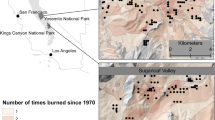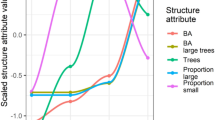Abstract
We examined the understory species composition of 24 remnant forest stands along an urban-to-rural gradient in the metropolitan Milwaukee, Wisconsin region to determine the relationships between plant community composition, human disturbance, and contrasting types of land use along a gradient of urbanization. A significant difference was found in shrub species community composition among three contrasting land-use categories but no significant difference was found in herbaceous community composition. Significant differences in human activity existed among rural, urban, and urbanizing land-use categories, but this index of disturbance was not significantly correlated to gradients in species composition. All stands in this study had been subjected to various types of human activity and environmental disturbances in the past. Our data suggest that differences in the relative importance of understory species exist among stands but these differences may not be caused by the impacts of urbanization alone. Changes in the natural disturbance regime of this landscape, along with the impacts associated with urbanization, have led to an individualistic response in the compositional dynamics of forest stands.
Similar content being viewed by others
References
Airola, T. M. and Buchholz, K. (1984) Species structure and soil characteristics of five urban forest sites along the New Jersey Palisades. Urban Ecol. 8, 149–164.
Auclair, A. N. (1976) Ecological factors in the development of intensive-management ecosystems in the midwestern United States. Ecology 57, 431–444.
Auclair, A. N. and Cottam, G. (1971) Dynamics of black cherry (Prunus serotina Erhr.) in southern Wisconsin oak forests. Ecol.Monogr. 41, 153–177.
Berry, K. J., Kvamme, K. L. and Mielke P. W., Jr. (1983) Improvements in the permutation test for the spatial analysis of the distribution of artifacts into classes. Am.Antiquity 48, 547–553.
Boehmer, C. M. (1976) A phytosociological study of the voluntary urban vegetation of Racine, Wisconsin. Ph.D. Thesis. University of Wisconsin–Milwaukee, Milwaukee, Wisconsin, 100 pp.
Brady, R. F., Tobias, T., Eagles, P. F. J., Ohrner, R., Micak, J., Veale, B. and Dorney, R. S. (1979) A typology for the urban ecosystem and its relationship to larger biogeographical landscape units. Urban Ecol. 4, 11–28.
Bray, J. R. and Curtis, J. T. (1957) An ordination of the upland forest communities of southern Wisconsin. Ecol.Monogr. 27, 325–349.
Brunner, M. C. (1977). Vegetation of forest edges. M.S. Thesis. University of Wisconsin–Milwaukee, Milwaukee, Wisconsin, 58 pp.
Curtis, J. T. (1959) The vegetation of Wisconsin – an ordination of plant communities. University of Wisconsin Press, Madison, Wisconsin, 675 pp.
Dorney, J. R., Guntenspergen, G. R., Keough, J. R. and Stearns, F. (1984) Composition and structure of an urban woody plant community. Urban Ecol. 8, 69–90.
Dunn, C. P. and Loehle, C. (1988) Species-area parameter estimation: testing the null model of lack of relationship. J.Biogeogr. 15, 721–728.
Forman, R. T. T. (1995) Land mosaics: the ecology of landscapes and regions, University Press, Cambridge, 632 pp.
Freedman, B. and Hutchinson, T. C. (1980) Long-term effects of smelter pollution at Sudbury, Ontario, on forest community composition. Can.J.Bot. 58, 2123–2140.
Gibson, D. J., Collins, S. L. and Good, R. E. (1988) Ecosystem fragmentation of oak-pine forest in the New Jersey Pinelands. Forest Ecol.Manag. 25, 105–122.
Gleason, H. A.(1952) The new Britton and Brown illustrated flora of the northeastern U.S.and adjacent Canada. Hafner Publishing Company, Inc., New York, 3 vols. 1732 pp.
Godron, M. and Forman, R. T. T. (1983) Landscape modification and changing ecological characteristics. In Disturbance and ecosystems: components of response (H. A. Mooney and M. Godron, eds), pp. 12–28. Springer– Verlag, New York.
Greller, A. M. (1975). Persisting natural vegetation in northern Queens County, New York with proposals for its conservation. Environ.Conserv. 2, 61–69.
Hamabata, E. (1980) Changes of herb-shrub layer species composition with urbanization in secondary oak forests of Musashino Plain near Tokyo: studies of the conservation of suburban forest stands. Jpn.J.Ecol. 30, 347–358.
Harper, K. T. (1963) Structure and dynamics of the maple-basswood forests of southern Wisconsin. Ph.D. Thesis. University of Wisconsin, Madison, Wisconsin, 116 pp.
Harris, L. (1984) The fragmented forest: island biogeography and the preservation of biotic diversity. University of Chicago Press, Chicago, Illinois, 211 pp.
Henderson, N. R. and Long, J. N. (1984) A comparison of stand structure and fire history in two black oak woodlots in northwestern Indiana. Botanical Gazette 145, 222–228.
Hobbs, E. (1988) Using ordination to analyze the composition and structure of urban forest islands. Forest Ecol.Manag. 23, 139–158.
Hoehne, L. M. (1981) The groundlayer vegetation of forest islands in an urban-suburban matrix. In Forest island dynamics in man-dominated landscapes (R. L. Burgess and D. M. Sharpe, eds), pp. 41–54. Springer-Verlag, New York.
Holzner, W. M., Werger, J. A. and Ikusima, I., eds. (1983) Man's impact on vegetation. Dr. W. Junk Publishers. The Hague, The Netherlands, 370 pp.
Kenkel, N. G. and Orloci, L. (1986) Applying metric and non-metric multidimensional scaling to ecological studies and some new results. Ecology 67, 919–928.
Kent, M. and Ballard, J. (1988) Trends and problems in the application of classification and ordination methods in plant ecology. Vegetatio 78, 109–124.
Kruskal, J. B. (1964) Nonmetric multidimensional scaling: a numerical method. Psychometrika 29, 115–129.
Levenson, J. B. (1976) Forested woodlots as biogeographic islands in an urban-agricultural matrix.Ph.D.Thesis. University of Wisconsin-Milwaukee, Milwaukee, Wisconsin, 101 pp.
Levenson, J. B. (1981) The southern-mesic forest of southeastern Wisconsin: species composition and community structure. Contributions in Biology and Geology 41. Milwaukee Public Museum, Milwaukee, Wisconsin, 246 pp.
Lindsey, A. A. (1955) Testing the line-strip method against full tallies in diverse forest types. Ecology 36, 485–495.
Loeb, R. E. (1982) Reliability of the New York City Department of Parks and Recreation's forest records. Bull.Torrey Bot.Club 109, 537–541.
Maarel, E. van der (1971) Plant species diversity in relation to management. In The scientific management of animal and plant communities for conservation (E. Duffy and A. S. Watt, eds.), Symp. British Ecological Society 11. Blackwell, Oxford, 45–63.
Mather, P. M. (1976) Computational methods of multivariate analysis in physical geography. John Wiley and Sons, London, 532 pp.
McCune, B. (1994) Improving community analysis with the Beals smoothing function. Ecoscience 1, 82–86.
McCune, B. and Cottam, G. (1985) The successional status of a southern Wisconsin oak woods. Ecology 66, 1270–1278.
McDonnell, M. J. and Pickett, S. T. A. (1990) The study of ecosystem structure and function along urban-rural gradients: an unexplored opportunity for ecology. Ecology 71, 1231–1237.
McDonnell, M. J., Pickett, S. T. A. Groffman, P., Bohlen, P., Pouyat, R. V., Zipperer, W. C., Parmalee, R. W., Carreiro, M. M. and Medley, K. (1997) Ecosystem processes along an urban-to-rural gradient. Urban Ecosystems 1, 21–36.
McIntosh, R. P. (1985) The background of ecology: concept and theory. University Press, Cambridge, 383 pp.
Meyer, W. B. and Turner, B. L. II, eds. (1994) Changes in land use and land cover: a global perspective – papers arising form the 1991 OIES Global Change Institute. University Press, Cambridge, 537 pp.
Middleton, J. and Merriam, G. (1983) Distribution of woodland species in farmland woods. J.Appl.Ecol. 20, 625–644.
Mielke, P. W., Jr. (1984) Meteorological applications of permutation techniques based on distance functions. In Handbook of statistics, volume 4, (P. R. Krishnaiah and P. K. Sen, eds), Elsevier Science Publishers, pp. 813–830.
Minchin, P. R. (1987) An evaluation of the relative robustness of techniques for ecological ordination. Vegetatio 69, 89–107.
MJM Software. (1995) PC-ORD Version 2.0. Multivariate analysis of ecological data. MJM Software Design, Gleneden Beach, Oregon, 126 pp.
Moran, M. A. (1984) Influence of adjacent land use on understory vegetation of New York forests. Urban Ecol. 8, 329–340.
Numata, M. (1977) The impact of urbanization on vegetation in Japan. In Vegetation science and environmental protection (A. Miyawaki and R. Tuxen, eds), pp. 161–171. Tokyo, Maruzen.
Ohga, N. (1979) Changes in distribution of vegetation types at Ichara City. In Integrated ecological studies in Bay-Coast cities (M. Numata, ed), pp. 61–69. Chiba, Japan.
Orloci, L. (1967) An agglomerative method for classification of plant communities. J.Ecol. 55, 193–206.
Pearson, C. J. (1976) Vegetation and environmental changes associated with intensification of agriculture near cities: a study of Sydney, Australia. Agric.Environ. 3, 31–43.
Peet, R. K. and Louckes, O. L. (1977) A gradient analysis of southern Wisconsin forests. Ecology 58, 485–499.
Peterken, G. F. and Game, M. (1984) Historical factors affecting the number and distribution of vascular plant species in the woodlands of central Lincolnshire. J.Ecol. 72, 155–182.
Profous, G. V. and Loeb, R. E. (1984) Vegetation and plant communities of Van Cortlandt Park, Bronx, New York. Bull.Torrey Bot.Club 111, 80–89.
Rieley, J. O. and Page, S. E. (1995) Survey, mapping, and evaluation of green space in the Federal Territory of Kuala Lumpur, Malaysia. In Urban ecology as the basis for urban planning (H. Sukopp, M. Numata, and A. Huber, eds), pp. 173–184. SPB Publishers, Amsterdam.
Rudnicky, J. L. and McDonnell, M. J. (1989) Forty-eight years of canopy change in a hemlock-hardwood forest in New York City. Bull.Torrey Bot.Club 116, 52–64.
Schmid, J. A. (1975) Urban vegetation – a review and Chicago case study. Research Paper 161, Department of Geography, University of Chicago, Chicago, Illinois, 266 pp.
Sharpe, D. M., Stearns, F. W., Burgess, R. L. and Johnson, W. C. (1981) Spatio-temporal patterns of forest ecosystems in man-dominated landscapes of the eastern United States. Proc. Int. Congr. Neth. Soc. Landscape Ecology, Veldhoven. Pudoc, Wageningen, pp. 109–116.
Sharpe, D. M., Stearns, F. W., Leitner, L. A. and Dorney, J. R. (1986) Fate of natural vegetation during urban development of rural landscapes in southeastern Wisconsin. Urban Ecol. 9, 227–237.
Sharpe, D. M., Guntenspergen, G. R., Dunn, C. P., Leitner, L. A. and Stearns, F. W. (1987) Vegetation dynamics in a southern Wisconsin agricultural landscape. In Landscape heterogeneity and disturbance (M. G. Turner, ed), pp. 137–155. Springer-Verlag, New York.
Shelton, N. (1974) Effects of urbanization on vegetation pattern: the case of Detroit, Michigan. Ph.D. Dissertation, University of Michigan, Ann Arbor, Michigan.
Shinners, L. H. (1940) The vegetation of the Milwaukee region. B.A. Thesis. University of Wisconsin, 87 pp. and 12 maps.
Stalter, R. (1981) A thirty-nine year history of the arborescent vegetation of Alley Park, Queens County, New York. Bull.Torrey Bot.Club 108, 485–487.
Sukopp, H., Numata, M. and Huber, A., eds. (1995) Urban ecology as the basis of urban planning. SPB Academic Publishing, Amsterdam, 218 pp.
Thomas, W. L., Jr., ed. (1956) Man's role in changing the face of the earth. University of Chicago Press, Chicago, Illinois, 1193 pp.
Tong, S. T. Y. (1989) On non-metric multidimensional scaling ordination and interpretation of the Mattoral vegetation in lowland Murcia. Vegetatio 79, 65–74.
Tuomisto, H., Ruokolainen, K., Kalliola, R., Linna, A., Danjoy, W. and Rodriguez, Z. (1995) Dissecting Amazonian biodiversity. Science 269, 63–66.
Weaver, M. and Kellman, M. (1981) The effects of forest fragmentation on woodlot tree biotas in southern Ontario. J.Biogeogr. 8, 199–210.
Whitney, G. G. and Adams, S. D. (1980). Man as a marker of new plant communities. J.Appl.Ecol. 17, 431–448.
Whittaker, R. H. (1967) Gradient analysis of vegetation. Biol.Rev. 49, 207–264.
Whittaker, R. H. (1972) Evolution and measurement of species diversity. Taxon 21, 213–251.
Wishart, D. (1969) An algorithm for hierarchical classifications. Biometrics 25, 165–170.
Whitford, P. B. and Salamun, P. J. (1954). An upland forest survey of the Milwaukee area. Ecology 35, 533–540.
Zimmerman, G. M., Goetz, H. and Mielke, P. W., Jr. (1985) Use of an improved statistical method for group comparisons to study effects of prairie fire. Ecology 66, 606–611.
Author information
Authors and Affiliations
Rights and permissions
About this article
Cite this article
Guntenspergen, G.R., Levenson, J.B. Understory plant species composition in remnant stands along an urban-to-rural land-use gradient. Urban Ecosystems 1, 155–169 (1997). https://doi.org/10.1023/A:1018523511071
Issue Date:
DOI: https://doi.org/10.1023/A:1018523511071




